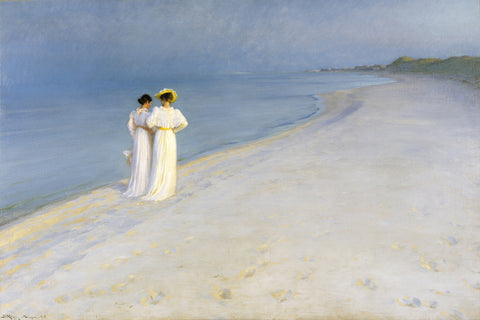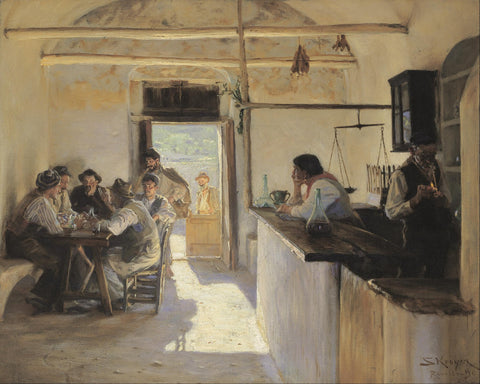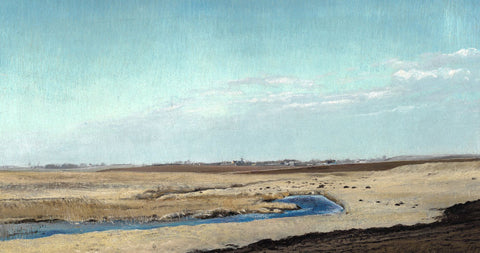Table of Contents:[hide]
In the annals of art history, certain names shine like beacons, illuminating the canvas of creativity. Peder Severin Krøyer, a Norwegian artist, stands tall among these luminaries. Renowned for his masterful brushstrokes and captivating depictions of light, Krøyer's contributions to the world of art are both profound and enduring.
1. Early Life and Artistic Beginnings
Peder Severin Krøyer was born on July 23, 1851, in Stavanger, Norway. His early passion for art led him to study at the Royal Danish Academy of Fine Arts in Copenhagen, where he honed his skills under the guidance of prominent mentors. Krøyer's early works showcased his fascination with the interplay of light and shadow, setting the stage for the artistic brilliance that would follow.
2. The Skagen Painters and Krøyer's Impact
Krøyer's artistic journey took a significant turn when he became associated with the Skagen Painters, a group of Scandinavian artists who found inspiration in the picturesque landscapes of Skagen, a Danish town. The play of light on the coastal scenes became a hallmark of Krøyer's work, and his contributions played a pivotal role in defining the Skagen School of painters.
3. The Skagen School's Artistic Philosophy
The Skagen School, led by Peder Severin Krøyer, embraced an artistic philosophy deeply rooted in the natural world. The artists sought to capture the transient beauty of the Skagen landscape, emphasizing the fleeting moments of light and shadow that danced upon the shores. This philosophy permeated Krøyer's oeuvre, setting him apart as a master of capturing the ephemeral beauty of nature.
4. Light and Atmosphere in Krøyer's Works
Krøyer's paintings from the Skagen period are characterized by their meticulous attention to light and atmosphere. His use of color and brushwork brings to life the vibrant sunsets, the cool hues of the sea, and the warm glow of sunlit figures. This emphasis on luminosity not only showcases Krøyer's technical prowess but also communicates the emotional depth of each scene.
5. Krøyer's Portraits and Social Realism
While the Skagen landscape dominated a significant portion of Krøyer's work, he also delved into portraiture and social realism. His portraits are marked by a keen understanding of human expression and a meticulous rendering of details. Krøyer's ability to capture the essence of his subjects, whether fellow artists or societal figures, solidified his reputation as a portraitist of exceptional skill.
6. International Acclaim and Exhibitions
Peder Severin Krøyer's art transcended national borders, earning him international acclaim during his lifetime. His works were featured in prestigious exhibitions across Europe, with critics lauding his ability to infuse ordinary scenes with extraordinary beauty. Krøyer's impact on the art world was further underscored by his role as a co-founder of the Free Exhibition, a platform that championed artistic freedom and innovation.
7. Krøyer's Enduring Influence
The legacy of Peder Severin Krøyer extends far beyond his lifetime. Modern artists continue to draw inspiration from his innovative techniques, particularly his mastery of light and atmosphere. The Skagen School's emphasis on capturing the essence of nature has left an indelible mark on landscape painting, with contemporary artists often citing Krøyer as a source of inspiration.
FAQs: Unveiling the Mystique of Peder Severin Krøyer
1. What is Peder Severin Krøyer best known for?
Peder Severin Krøyer is best known for his contributions to the Skagen School of painters, where he masterfully captured the play of light and atmosphere in the landscapes of Skagen, Denmark. His ability to infuse scenes with luminosity and emotion set him apart as a leading figure in Scandinavian art.
2. How did the Skagen School influence Krøyer's artistic style?
The Skagen School's emphasis on capturing the transient beauty of nature profoundly influenced Krøyer's artistic style. He became renowned for his meticulous attention to light, atmosphere, and the interplay of colors in his paintings, creating a distinctive aesthetic that defined the Skagen School.
3. Did Krøyer exclusively paint landscapes?
While Krøyer's landscapes, especially those of Skagen, are iconic, he also explored other genres, including portraiture and social realism. His portraits, marked by detailed rendering and a keen understanding of human expression, showcase the versatility of his artistic talent.
4. What role did Krøyer play in the art world during his lifetime?
Peder Severin Krøyer played a crucial role in the art world during his lifetime. His international acclaim, participation in prestigious exhibitions, and co-founding of the Free Exhibition highlighted his commitment to artistic freedom and innovation. Krøyer's influence extended beyond his works to shape the broader artistic landscape.
5. How does Krøyer's legacy endure in contemporary art?
Krøyer's legacy endures in contemporary art through his enduring influence on techniques such as capturing light and atmosphere. Modern artists often look to Krøyer as a source of inspiration, drawing from his innovative approaches to create evocative and emotionally resonant works.
Conclusion:
Peder Severin Krøyer's artistic journey, from his early days at the Royal Danish Academy to his pivotal role in the Skagen School, is a testament to the enduring power of creativity. His ability to capture the fleeting beauty of nature and the profound depth of human expression has left an indelible mark on the art world, making him a revered figure in the pantheon of art history. As we continue to appreciate Krøyer's masterpieces, his legacy lives on, casting a radiant glow over the world of art.
Prints and Canvas Panels
Fine art prints and ready to hnag canvas panels of Peder Severin Krøyer's are available in a range of sizes.
Related Articles
Scandinavian & Nordic Artists





